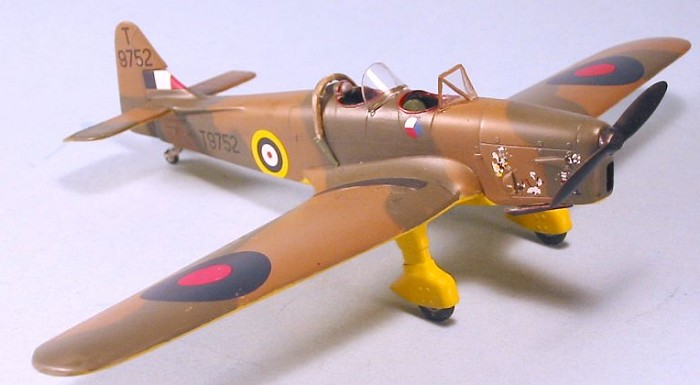
| KIT: | Flashback 1/48 Miles Magister |
| KIT #: | ? |
| PRICE: | $24.00 MSRP |
| DECALS: | Two options |
| REVIEWER: | Tom Cleaver |
| NOTES: | Kit is currently out of production |

| HISTORY |
What became known as the Miles Magister was first flown on March 20, 1937, as the Miles Hawk Trainer III, designed and built in response to the Air Ministry Specification 40/36, which was developed on the basis of experience with the Miles M.2Y Hawk Trainer II in No. 8 Elementary Flying Training Squadron at Woodley during 1936.
The Miles M.14, as the design was known to the company, was the first
low-wing monoplane trainer to be built for the RAF. The airplane was
roughly similar in performance with the Fairchild PT-19 “Cornell,” used in
the United States. The airplane was of all-wood construction with plywood
stressed skin; the wing was built in three sections that could be folded to
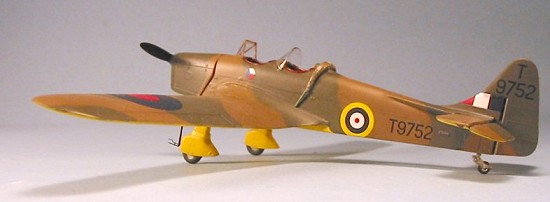 conserve space. The
instructor and student were seated in tandem open cockpits, each with a
full set of instruments, and the rear cockpit had a folding canvas hood
that could be used for instrument flying training.
conserve space. The
instructor and student were seated in tandem open cockpits, each with a
full set of instruments, and the rear cockpit had a folding canvas hood
that could be used for instrument flying training.
Deliveries of the M.14 began in June, 1937. The initial M.14 was followed by the definitive M.14A Magister I, which had a taller rudder, deeper rear fuselage, and - eventually - anti-spin strakes on the rear fuselage.
Powered by a 130 h.p. deHavilland Gipsy Major I, the Magister had a maximum speed of 140 m.p.h., an initial climb rate of 1,200 ft/min, a service ceiling of 16,500 ft. and a range of 367 miles.
The Magister, popularly known throughout the RAF as the “Maggie,”
eventually equipped 16 Elementary Flying Training Schools in Britain, where
it was second in importance after the deHavilland Tiger Moth and was
particularly useful for pilots
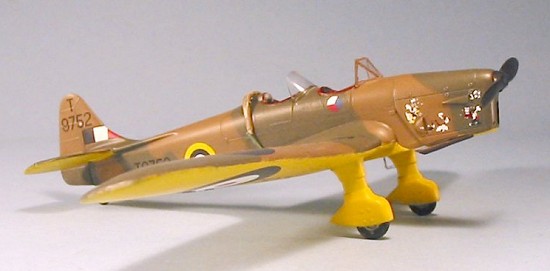 who would later fly
Spitfires and Hurricanes as an introduction to monoplanes, since it had a
higher performance than the Tiger Moth. It was used as a communications
“hack” by many operational squadrons in Britain throughout the war.
who would later fly
Spitfires and Hurricanes as an introduction to monoplanes, since it had a
higher performance than the Tiger Moth. It was used as a communications
“hack” by many operational squadrons in Britain throughout the war.
The RAF diverted 15 Magisters to the Irish Air Corps in 1939, and 23 to the Royal Egyptian Air Force in 1940. 30 ex-RAF Magisters were transferred to the Turkish Air Force in 1943, while the type saw service with the RAAF, where it was known as the Hawk Trainer.
In June, 1940, 16 Magisters were adapted to carry 8 25-lb anti-personnel bombs under the wing center-section, for use in ground attack against the expected German invasion.
When production of the Magister ceased in 1941, 1,203 had been built. After the war, many wound up on the civil list. There are seven Magisters around the world that still fly.
| THE KIT |
Flashback released their 1/48 kit of the Magister in 2002. With less than 20 parts, it is a very simple model, and has decals for two aircraft, including a colorful hack flown by the Czech-manned 310 Squadron in 1940, with nose art of Walt Disney characters. At a retail price of $24.00, the kit was likely over-priced, and I have only ever seen a few built up.
| CONSTRUCTION |
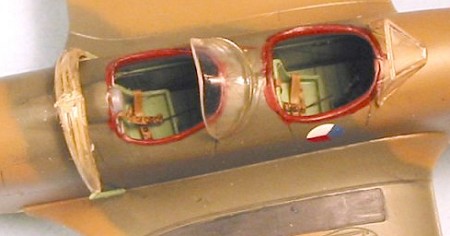 Construction is
very basic. There are sufficient cockpit parts to provide the look of the
simple cockpits, and they fit inside the fuselage halves without
difficulty. The wings are two part, as is the landing gear. The entire
model took less than three hours to paint the cockpit parts, assemble them,
and assemble the entire kit. There are no fit problems, and I used Mr.
Surfacer 500 to get rid of seams.
Construction is
very basic. There are sufficient cockpit parts to provide the look of the
simple cockpits, and they fit inside the fuselage halves without
difficulty. The wings are two part, as is the landing gear. The entire
model took less than three hours to paint the cockpit parts, assemble them,
and assemble the entire kit. There are no fit problems, and I used Mr.
Surfacer 500 to get rid of seams.
| COLORS & MARKINGS |
Painting:
I used Tamiya “Flat Yellow” for the lower surfaces, and Gunze Sangyo “Dark Earth” and “RAF Dark Green” for the upper surfaces. I did a “hard-edge” camouflage pattern using drafting tape, with thread run just in from the edge to lift it and avoid a “paint ridge” for the colors. I finished this off with a coat of Future.
Decals:
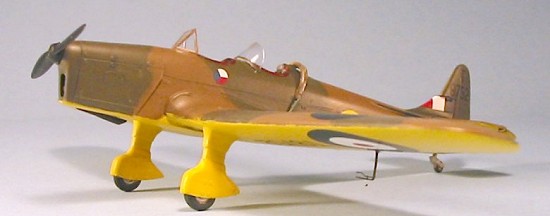 I did the 310
Squadron hack, since these were the more colorful markings provided. The
well-printed kit decals went on without problem, and the model was sealed
with a second coat of Future when they had dried.
I did the 310
Squadron hack, since these were the more colorful markings provided. The
well-printed kit decals went on without problem, and the model was sealed
with a second coat of Future when they had dried.
| FINAL CONSTRUCTION |
As an all-wood airplane, there was no “dinging” to be done. A hack would have been well cared-for, so I kept the model clean. I inserted the wheels into the gear spats, attached the prop and the folded canvas hood, and finally the wind screens.
| CONCLUSIONS |
This is an extremely easy kit to build. If you are just back to the hobby and spot one on a dealer’s table at a show, it will likely have a low price that will provide good quality for value - as I found when I bought this one a year after it had been released. Every once in awhile, a nice simple little kit like this is a good break from big projects like the upcoming Fw-200 build.
July 2005
Kit courtesy of my wallet.
If you would like your product reviewed fairly and quickly by a site that has nearly 300,000 visitors a month, please contact me or see other details in the Note to Contributors.